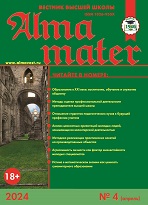UDC 316:378
https://doi.org/10.20339/AM.06-22.030
Alexey R. Ganeev, Ph.D. in Engineering Science, Vice President of Union “Professionals in the field of educational innovations”, e-mail: mail@rosobrsoyuz.ru
Natalia A. Bulaeva, Ph.D. in Economics of Union “Professionals in the field of educational innovations”, e-mail: mail@rosobrsoyuz.ru
Ivan A. Ruban, Director General at Verkont Service LLC, e-mail: monitor@vercont.ru
The article defines the peculiarities of distance educational technologies application in the period of the new coronavirus pandemic and substantiates the necessity to monitor the processes of distance educational technologies application. The authors give an estimate of the degree of readiness of the higher educational establishments to the high-quality distance education, the assessment of the students’ academic load change was held when implementing the distance education, and the issues of change of the students’ motivation level to the distance education were considered. The conditions of the teachers’ on-site Internet access in the higher educational institution were assessed, as well as the level the students’ technical capacities for distance education. The authors classified the main issues faced by the teachers and students in the process of distance education, as well as presented the offers to improve the distance education organization. The following conditions for the distance education improvement were stated: provision of the students and teachers with high speed Internet, equipping the classroom with special distance learning facilities (notebooks, video hardware, touchpads, VR equipment, including creation and purchase of virtual laboratories), providing the teachers with technical facilities for distance work, teachers’ training in the field of information and computer technologies.
Key words: higher education organizations, distance education, distance education technologies, monitoring, survey, level of satisfaction.











.png)






